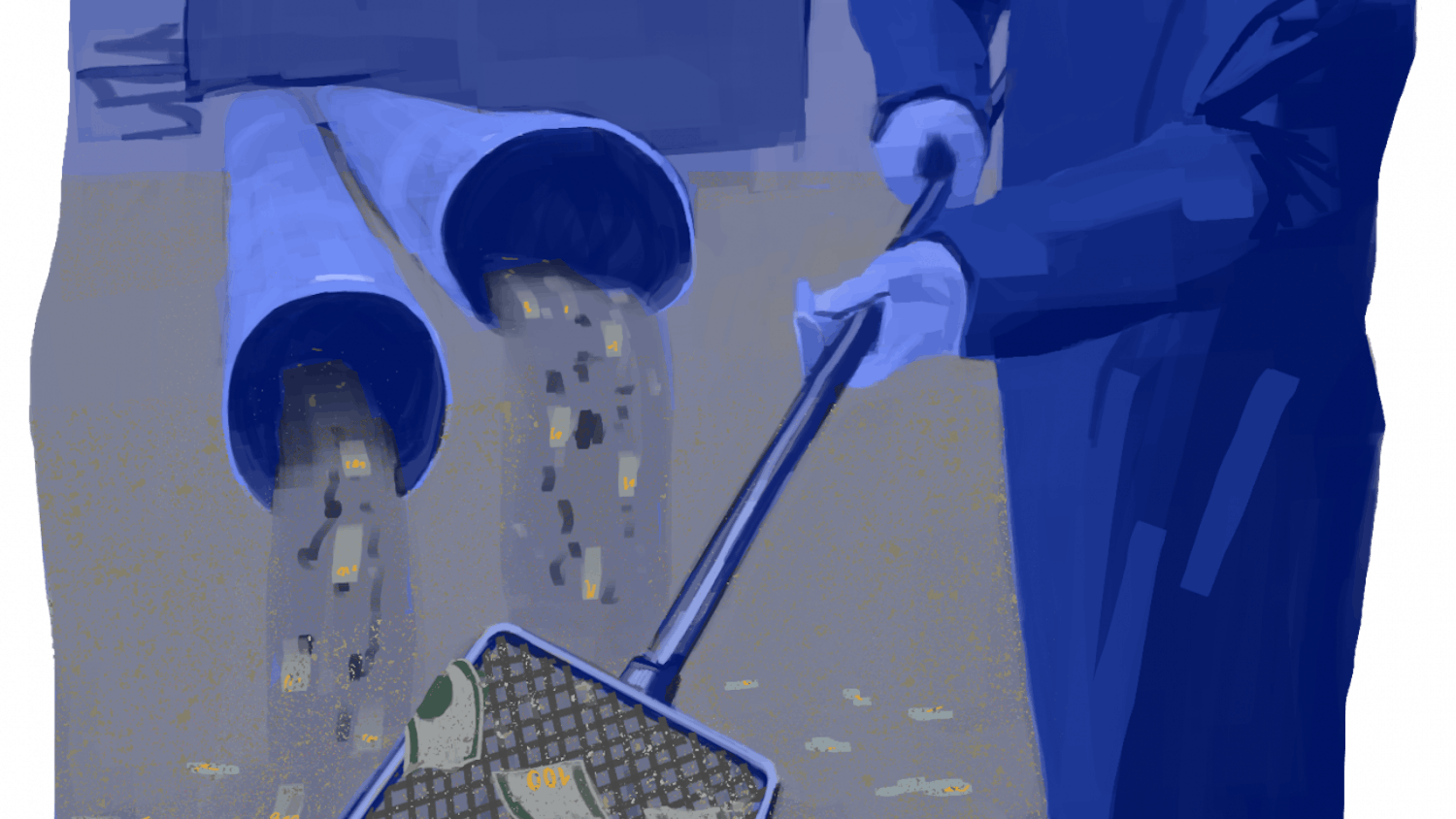Down in the dimly-lit basement of the Sharpe Refectory, somewhere roughly two stories below the salad bar, Joe Barboza, facilities manager for Dining Services, points to a stack of white boxes piled up almost to the ceiling. "This is this week's supply of French fries," he said. "You guys consume a lot of food."
The Ratty serves thousands of Brunonians each day. About 123 people work there full-time, Barboza said, along with 300 or so part-time student employees. Work starts at 4 a.m. and continues until late at night. Barboza offered The Herald a tour of the Ratty's three levels - the basement, where food is stored, the kitchen level, where it is prepared and finally, the dining hall, where it is served.
Delivery
Food arrives at the Ratty from across the country. The receiving bay opens out onto Thayer Street and is connected directly to the kitchen. Deliveries begin at 6:30 a.m. and continue until noon, Barboza said.
Though some of the food comes from places such as Pennsylvania and Vermont, Dining Services is committed to buying from local, fair-trade producers whenever it can. Anna Rotman '14, a Dining Services sustainability intern, said currently 36 percent of the food Dining Services buys meets or partly meets criteria set by the "Real Food" initiative. "Real" food is food that is local, fair, ecologically sound and humane, she said.
Once it has arrived, the food is unloaded by a team of four - a lead receiver and three helpers, Barboza said. Dried and canned food is then brought downstairs to the basement via a large elevator in the receiving bay, while fruits, vegetables and perishables go straight into refrigerators on the kitchen level.
At one end of the basement there are two large walk-in freezers, which Barboza said were "probably larger than the square footage of your house." In another corner is a fenced-off space full of shelves that Barboza called the "spice cage."
A series of compressors also hum away in the darkness, chilling the 11 smaller refrigerators upstairs. Barboza said the compressors were once cooled with water that was then flushed straight into Narragansett Bay. But a year and a half ago, the Ratty was equipped with a new system that pumps the water up to a pool on the roof where it loses heat and is then reused in the compressors. Barboza said that after Dining Services installed the new system, annual water usage fell by 16 million gallons.
"It has saved the University thousands of dollars," Barboza said.
Up on the kitchen level, the refrigerators that store perishables resemble long hallways between the receiving bay and the kitchen. Barboza explained they are shaped this way because they function on a "first in, first out" rule. Deliveries come in at one end of the refrigerator and slowly move toward the other end as the older food ahead of it gets used first, so that food doesn't go bad before it is served, he said.
Preparation
The kitchen takes up the majority of the space immediately below the dining hall and is divided into several different areas. Each morning cooks are given a production task based on their culinary skills, Barboza said.
The first to arrive each morning are the bakers, Barboza said, who start work at 4 a.m. They make all the bread, cookies and desserts served not only in the Ratty but also in other dining halls. The dough for the pizza at the Gate, he said, is first made by bakers in the Ratty kitchen.
"The only thing we don't make are bagels and croissants," Barboza said. "They take far too long."
The bakers have at their disposal a rotary oven, which can cook 64 trays of baked goods simultaneously, Barboza said.
The kitchen also has a small butcher shop. Barboza said Dining Services employees cut 90 percent of the meat served at Brown, which few colleges do anymore. "We don't know what the quality is like in some butcher's shop in Kansas City," he said. "This way I've seen it, stamped it, cut it - I can account for that meat until you get it yourself."
Jonathan Sit '15 said he was impressed the Ratty had its own butcher shop, but in the end he said he does not care where his meat comes from. "I mean, if you eat Burger King, you already have pretty low standards," he said.
Most of the rest of the cooking happens in a central area filled with large machines for cooking food in bulk. Barboza pointed out nine steamers, eight convection ovens, one combination oven, eight 60-gallon steam kettles, one 100-gallon steam kettle, one tilt skillet and six frialators. "(The frialators) are for the chicken fingers," Barboza said.
Serving and Disposal
Barboza said food is "cooked progressively" throughout the day.
Barboza referred to the central area of the Ratty as the "core," which he further divided into the "inner core" and the "outer core." Much like the refrigerators on the kitchen level, a series of hollow cabinets divide the inner core from the outer core, so that food can be put in at one end and taken out to serve at the other. Barboza said extra trays of food are kept in the cabinets, which can act as either refrigerators or warmers.
Barboza said the kitchen tries to cook just enough food for each day. "It's a good day when there are only a couple of potatoes left," he said. By using statistical information gathered through card-swipes, he said they were able to predict with some accuracy how much food they need throughout a day.
Of the food that is thrown away, Barboza said most of it ends up as compost or is fed to the pigs at Two Village Farm. But he said sometimes plastic trash ends up in the food waste bin, which forces Dining Services to dispose the entire bag, as Two Village Farm won't accept it. He pointed out that the food waste bags are transparent so they can be inspected for contamination.
Dave Thomas '15 said he is usually careful to separate his trash properly, as he knows that food waste goes to a pig farm. But he feels Dining Services does not make it clear enough how easy it is to contaminate the food waste bin.
"They should put up a sign, saying that if you put one piece of trash in there they can't use it," he said.
Even the food left on dirty plates is scraped off and made into compost after the plates are taken downstairs to the dish-washing line. As they are scraped clean, the food slides down a groove into a Somat machine, which grinds the food and any paper waste into small bits
, Barboza said. Though Dining Services currently hasn't found anyone to buy this compost, Barboza said they are still looking.
Lillian Mirviss '12, another sustainability intern for Dining Services, said composting is difficult in Providence. "It's challenging to start our own (compost) network here because of the many barriers the city provides."
But she said measures to decrease food waste in the first place - such as the switch to tray-less dining made in 2008 - have been very successful. According to the Dining Services website, tray-less dining usually reduces food waste by over 25 percent.
Barboza said if the kitchen makes too much food one day, the food that can be served later is stored. The food that will not last is put into a small, conventional refrigerator in the receiving bay. The food then goes to a charity called "We Share Hope" in Warren, R.I., which provides food to other organizations feeding the poor and homeless, Barboza said.
The tour concluded near the offices of Dining Services where pictures of the Ratty from the 1950s - the dining hall's early years - line the walls. In one of them, groups of eight men sit at tables waiting patiently for their food to be brought to them. Waiters stand patiently, ready to serve the students once their food is ready. But waiters have not served food in the Ratty since 1966, Barboza said.
"The tables haven't changed," he said. "But we do things very differently now."




